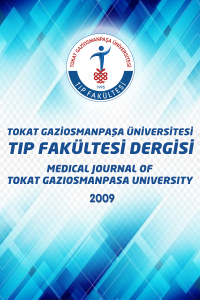Su Banyosu ve Mikrodalga Enerjisi ile Post-Polimerizasyon Uygulamalarının Protez Kaide Rezinlerinden Salınan Artık Monomer Miktarı Üzerine Etkisi
Amaç: Bu çalışmanın amacı farklı postpolimerizasyon yöntemlerinin, ısı ile polimerize olan protez kaide rezinlerinden salınan artık monomer miktarına etkisinin değerlendirilmesidir. Gereç ve Yöntem: Çalışmada ısı ile polimerize olan QC-20 akrilik rezini ve yüksek çarpma direncine sahip olan ısı ile polimerize olan SR-Ivocap high impact enjeksiyon akrilik rezini kullanılmıştır. Her bir akril grubu kendi içerisinde postpolimerizasyon uygulanmayan kontrol grubu (G1), 550 W/5 dkmikrodalga enerjisi ile post-polimerizasyon uygulanan grup (G2) ve 55 ºC’de 1 saat su banyosu ile post-polimerizasyonuygulanan grup (G3) olmak üzere 3 gruba ayrılmıştır. Artık monomeranalizi için her akril grubundan 10’ar adet (n=10) olmak üzere toplam 60 adet 50 mm çapında 3 mm kalınlığında disk şeklinde örnekler hazırlanmıştır. Artık monomer analizi ultraviyole spektrofotometre yöntemi ile analiz edilmiştir. Elde edilen artık monomertest sonuçlarının istatistik değerlendirilmesi tek yönlü varyans analizi (ANOVA) kullanılarak yapılmıştır. Gruplar arası farklılıklar DUNCAN testi kullanılarak karşılaştırılmıştır. Bulgular: Artık monomer miktarı bakımından akrilik rezin ve uygulanan post-polimerizasyon yöntemleri arasında istatistiksel olarak önemli interaksiyon saptanmıştır (p<0,05). Yani kaide rezinlerinden salınan artık monomer miktarı hem akril çeşitlerine göre hem de uygulanan post-polimerizasyon yöntemlerine göre istatistiksel olarak birbirinden farklılık göstermiştir. En düşük artık monomer miktarı QC-20 örneklerini içeren gruplarda gözlenmiştir. QC-20 örneklerine uygulanan post-polimerizasyon işlemleri için gruplar arasında istatistiksel bir fark gözlenmemiştir. SR-Ivocap high impact akrilik örneklerine uygulanan postpolimerizasyon işlemlerinden mikrodalga enerjisi ile post-polimerizasyon işlemi istatistiksel olarak farklılık göstermekle birlikte artık monomer miktarını azaltmamıştır. Sonuç: Polimerizasyon sonrası 55ºC’de 1 saat su banyosuna daldırma ve550 W’da 5 dakika mikrodalga enerjisi ile uygulanan post-polimerizasyon yöntemlerinin, ısı ile polimerize olan QC-20 ve SR-Ivocap high impact enjeksiyon akriliklerinden salınan artık monomer miktarını azaltma da etkinliği gösterilememiştir.
The Effect of Water-Bath and Microwave Post-Polymerization Treatments on the Residual Monomer Content of Denture Base Resin
Objectives: The aim of this study was to evaluate the effect of different postpolymerization methods on the residual monomer content of the heat cure dacrylic resins. Material and Methods: In this study QC20 heat cure dacrylic resin and SR-Ivocap high impact heat cure dacrylic resin were used. Each of acrylic resin material divided into three groups. Group I specimens were left untreated (GI- control). Specimens of group II (GII) were given postpolymerization treatment by microwave irradiation at 550 W for 5 minute. In group III (GIII), specimens were submitted to immersion in water at 55 ºC for 1 hour. Disc-shaped specimens of eachmaterial (n=10), with dimensions of 50 diameter and 3 mm in thickness were produced. The residual methylmethacrylate content of the test specimens was determined by ultraviolet spectrophotometry. In this study, the data on residual monomer were analyzed by applying ANOVA. If necessary, the differences between groups were controlled using DUNCAN multiple test. Results: The result of ANOVA indicated that there was a statistically significant interaction between acrylic resins and the applied processes in terms of residual monomer (p<0.05). Therefore, the main effect of the acrylic resins, and the applied processes were compared with each other separately. The lowest amount of residual monomer was observed in the group consisting of QC-20 samples. There were nosignificiant differences between QC-20 acrylic resin groups. There was statistically significant different for SR-Ivocap high impact acrylic resin samples which treated with microwave post-polimerization. Although the microwave polymerization didn’t reduce the amount of residual monomer of SR-Ivocap high impact acrylic resin samples. Conclusion: The effectiveness of the water bath (55 ºC for 1 hour) and microwave (550 W for 5 minute) post-polymerization treatments weren’t shown on the reduce the amount of residual monomer of QC-20 heat cured acrylic resin and SR-Ivocap high impact acrylic resin
